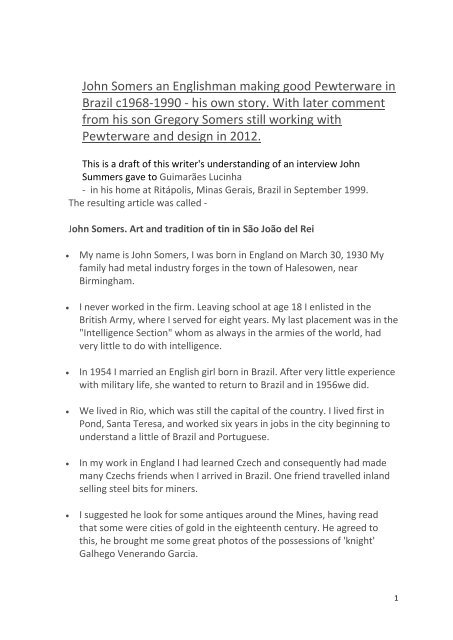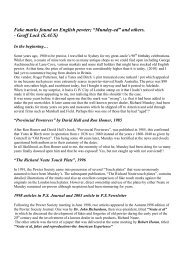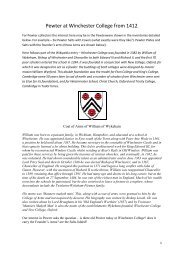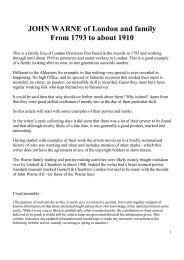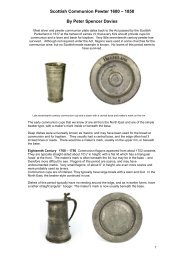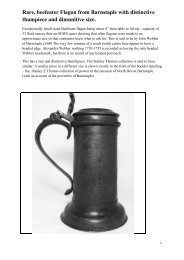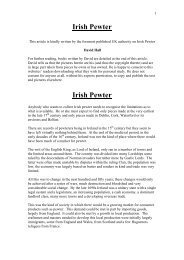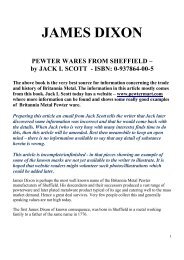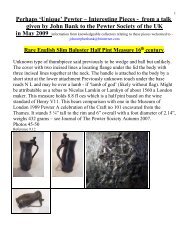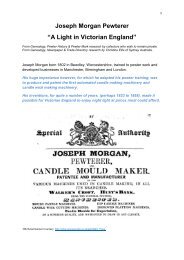Untitled - PewterBank
Untitled - PewterBank
Untitled - PewterBank
Create successful ePaper yourself
Turn your PDF publications into a flip-book with our unique Google optimized e-Paper software.
John Somers an Englishman making good Pewterware in<br />
Brazil c1968-1990 - his own story. With later comment<br />
from his son Gregory Somers still working with<br />
Pewterware and design in 2012.<br />
This is a draft of this writer's understanding of an interview John<br />
Summers gave to Guimarães Lucinha<br />
- in his home at Ritápolis, Minas Gerais, Brazil in September 1999.<br />
The resulting article was called -<br />
John Somers. Art and tradition of tin in São João del Rei<br />
<br />
<br />
<br />
<br />
<br />
<br />
My name is John Somers, I was born in England on March 30, 1930 My<br />
family had metal industry forges in the town of Halesowen, near<br />
Birmingham.<br />
I never worked in the firm. Leaving school at age 18 I enlisted in the<br />
British Army, where I served for eight years. My last placement was in the<br />
"Intelligence Section" whom as always in the armies of the world, had<br />
very little to do with intelligence.<br />
In 1954 I married an English girl born in Brazil. After very little experience<br />
with military life, she wanted to return to Brazil and in 1956we did.<br />
We lived in Rio, which was still the capital of the country. I lived first in<br />
Pond, Santa Teresa, and worked six years in jobs in the city beginning to<br />
understand a little of Brazil and Portuguese.<br />
In my work in England I had learned Czech and consequently had made<br />
many Czechs friends when I arrived in Brazil. One friend travelled inland<br />
selling steel bits for miners.<br />
I suggested he look for some antiques around the Mines, having read<br />
that some were cities of gold in the eighteenth century. He agreed to<br />
this, he brought me some great photos of the possessions of 'knight'<br />
Galhego Venerando Garcia.<br />
1
The same night I travelled to Sao Joao del Rei, and the next day, I was<br />
able to buy a lot of antiques. I spent all my free time in the basement of<br />
the house at Santa Teresa. It took me two years to classify and identify<br />
my purchases.<br />
<br />
<br />
<br />
<br />
<br />
<br />
<br />
<br />
I had a lot to learn. After two years I knew much of Brazil's past. In 1960 I<br />
had the opportunity to rent a home in the Largo of the Apothecary, and<br />
decided to sell my antiques there.<br />
I spent a few happy years as a slightly bohemian antiquarian. The store<br />
reached prospered moderately. But eventually I realized that the Mines<br />
were diminishing as useful sources for antiques. At first there was a truck<br />
a week to buy, then each month, then every six months and in the end,<br />
one per year.<br />
I had set up a repair shop in Sao Joao del Rei, employing three excellent<br />
workmen who as carpenters and blacksmiths were also able to make<br />
fittings for the antique furniture.<br />
These people were very skilled, and they had a great desire to learn,<br />
work. We learnt together. My aim was always to renovate the furniture<br />
back to its original state.<br />
Soon I had to be interested in quicker turnover. The furniture of the<br />
region was very cute, today it is widely rare to find a good piece in its<br />
place of origin.<br />
Even at that time was rare to find a piece in its original state. Furniture<br />
Style Dom Joao V I have not found, as that even then had already been<br />
sold off.<br />
But I did not worry, because I preferred the country furniture style of the<br />
miner, I admired its straight lines.<br />
My experiences in antiques were formative in my future life. Why<br />
someone takes an interest in the past is a mystery. Is it an escape<br />
mechanism Even more mysterious is why a person, I in this case, comes<br />
to appreciate the past of a people or a country other than their own.<br />
2
One possible explanation is that Brazil I've seen in 60 years, was like a<br />
living laboratory of facts already forgotten in Europe.<br />
Brazil is a Portuguese style of country, and in being so it preserves the<br />
legacies of the Moors, the Romans, and the pre-Roman and Lusitani<br />
Brigantes. The ox cart, to this day with massive wheels, was made by<br />
Lusitani (early Portuguese peoples).<br />
Silver in Brazil is not handled with care, it should be polished and stored<br />
in a cloth when not in use. Here silver was a metal tool, and was rubbed<br />
clean with sand and lime., As the Romans did, and this soon reduces it to<br />
a matte, dull surface.<br />
Often silverware was painted white to avoid the work of cleaning it. I<br />
remember furniture with silver handles and candlesticks of tin, painted<br />
white. Strangely there were materials to clean metals in the interior.<br />
There are other examples of the remote past, which were still used in<br />
1960:<br />
· the use of childbirth chairs, with a hole in the middle.<br />
. the use of manufactured wire to manually make "jewellery", now<br />
known as jewellery, (the same procedure was described by Theophilus, c.<br />
1140) · . the isolation of farms around the world or European<br />
metropolitan: . . . . . . . watches, sometimes in archaic Portuguese had<br />
instructions on how to tell the time if unable to see the movement of the<br />
sun (guessed).<br />
. the farm could have one cabinetmaker / carpenter, able to make<br />
without instruction simple furniture of great beauty.<br />
. and if the farm had no blacksmith, then the drawers might be without<br />
handles.<br />
. the furniture, sometimes continued from century to century even until<br />
our time, without handles, or maybe waiting 50 or 100 years after being<br />
made to be completed with knobs or locks. This state of affairs lasted<br />
until the late nineteenth century.<br />
The proof is in the casting of the farm's flatware, silver low, very low,<br />
using English or French models of age. One of the antiques was the<br />
common "boxes" to melt spoons and forks, and larger pieces to make<br />
stirrups.<br />
3
I remember seeing farmers coming to town to deposit money in the<br />
bank, wearing faded suits, made from their farms cotton, walking<br />
barefoot, and carrying the money in cotton bags. ·<br />
The term 'farm', an autarchic economic unit, as old as the time of<br />
Charlemagne. The builders of farms drew one construction that<br />
externally had the appearance of a house. Upon entering the home,<br />
however, were large rooms occupied for storing rice, coffee, beans.<br />
Other rooms used for the production of saddlery, bridles, or stirrups, and<br />
rooms for spinning and weaving the clothes of the family.<br />
Kubitschek ( who was a prominent Brazilian politician of gypsy Czech<br />
origin who was President of Brazil from 1956 to 1961. He was born in<br />
Diamantina, Minas Gerais, and died in 1976. His term was marked by<br />
economic prosperity and political stability, being most known by the<br />
construction of a new capital, Brasília).<br />
He wanted to make new roads and open up the Brazilian countryside, but<br />
the result was to make money, laboriously carried in bags for banks,<br />
flowing to Sao Paulo and the Cobbler. ·<br />
In the house of my cousin, a farmer in the country of Wales, had an<br />
outside toilet which was very sociable, raised upon a brook, with two<br />
seats side by side, now no longer used.<br />
I saw one like it in Bavaria, but still in use in 1950. In Ouro Preto one day I<br />
saw a house being remodelled, modernized. One of the pieces of junk<br />
coming out of the house was a plank with three seats. ·<br />
Musical instruments were rare, probably because of their delicacy and<br />
fragility, but I remember a bass made of galvanized tinplate (For some<br />
time I had a native secretary, descended from a long line of luteiros). Of<br />
course there were also hundreds of Bohemian Stradivarius. ·<br />
I remember discovering amid the disposal of Sgnr. Venerando's<br />
possessions a lamp or candle holder, of iron made in Germany, c. 1450.<br />
Why had this been in Minas Gerais from 1700<br />
4
I remember a clip of three fingers threw it away, thinking it was a trinket<br />
modern ice pick or olives. Many years later I realized it was very rare tool<br />
a surgeon to remove a bullet round from the wounded.<br />
The weapons of the militia in the interior were very diverse. I remember<br />
a sword straightened out, which bore the inscription Henry Espadero en<br />
Colonia del Rey, which presumably was used against the Dutch in their<br />
war of independence of the fifteenth century. When I saw it in Minas, it<br />
had already been there for 200 years.<br />
The phrase "backfire" is significant: no one knew better than poor old<br />
owner of a rifle that I saw, which had exploded in the breech in the face<br />
of the shooter. ·<br />
With little income for window curtains, the windows had painted<br />
beautiful wood moldings. I had a similar mold, whose only explanation<br />
was to decorate the streets during Holy Week with flower petals. ·<br />
Locks and secrets were a constant concern of those who had something<br />
to hide. I had a closet that had been assaulted with heavy tools around<br />
and above the frame, which had been very beautiful. Presumably the<br />
father died without telling both sons the secret of how to open the<br />
hidden or locked compartments. The secret was hidden in a lower<br />
drawer.<br />
One day someone came to the door of my shop and offered me a pretty<br />
box, or case, but the lock was missing. It looked like the lock had been cut<br />
out, it was not a simple rectangle. I bought the box and I found that my<br />
hardware stock did not have a lock any such size.<br />
The principle farms of the eighteenth century were painted, inside and<br />
out, with colours and paintings of enormous charm and grace. I<br />
remember a farm where the chapel had been decorated and sculpted by<br />
patron Aleijadinho.<br />
I remember another farm from which the dining table was so large that it<br />
had been made in the room. Years later a friend told me that he was<br />
born on that farm.<br />
5
I remember a closet, reduced to a skeleton, no doors, no drawers, of a<br />
design I had never before seen. Wood was Brazilian, but not from Minas<br />
Gerais. I suspected that it was made in Portugal of imported Brazilian<br />
woods, and brought to Brazil. Years later I discovered that the type was<br />
common in the region of Porto in Portugal.<br />
I remember a type of mirror lock, and also handle plate, which was<br />
stamped brass but with a flow in the centre. I later discovered that these<br />
handles were English, of the century. XVIII and had pictures of Battersea<br />
enamelled in the centre.<br />
Meanwhile, my workshop had expanded to include the repair of copper<br />
and brass, most of which I bought in England. When I noticed that my<br />
purchases of pewterware sold first, the idea occurred to me to buy new<br />
pewter in Europe to sell in Brazil.<br />
But in Europe there was only one manufacturer producing pewter in<br />
ancient styles and quality appropriate to the quality of my vernacular<br />
furniture of the region. I thought then of making the pewterware, here.<br />
It took me six months of reading the few books that existed at the time<br />
about it. I found little information. Finally I took courage and began to<br />
experiment with simple items such as plates and cups.<br />
At the time I had a worker, Carlos Adilson, who was a blacksmith genius<br />
and solved any problem, he understood everything I wanted to know, he<br />
knew about electricity, turning, casting, copper, brass, iron, polishing,<br />
welding, whatever.<br />
Then I decided try something more ambitious. In 1968, the Church of the<br />
Rosary of Tiradentes functioned as a museum. There were in the Church<br />
three baroque candlesticks.<br />
I do not have much luck with Catholic priests, and asked Carlos, the<br />
blacksmith genius, and one other worker who was wonderful with<br />
design, despite never having taken classes in industrial design to copy the<br />
candlestick which I managed to have on loan from the parish priest.<br />
In return, I promised the first pair we made would be given to the priest.<br />
The experiment was a success, but imagine my disappointment to learn<br />
6
that the same day we gave them to him, the priest put the candlesticks<br />
under his arm and went knocking door to door in Tiradentes trying to sell<br />
them.<br />
With a collection of photographs of our production of not more than<br />
seven or ten pieces, including candlesticks, I then went to England to<br />
seek a firm with whom we could associate. They were very impressed<br />
with the picture of the candlesticks, and we started talking.<br />
Whilst there, I had been learning in their workshop. After three weeks,<br />
their proposal was not viable, but I had already learned everything we<br />
needed.<br />
This great man, Carlos, then disagreed with me for no good reason<br />
because of some metalwork that was missing. He left the firm and soon,<br />
he opened his own factory, fully assembled! It was a great loss to the<br />
craftsmanship of São João del Rei when he suffered an accident that left<br />
him unable to work.<br />
In 1970 I separated from my first wife, who died in 1974. Our son<br />
Gregory lives in St. John near us, with his wife and two beautiful children.<br />
Over the years I collected old pewter, mainly from pewter that existed in<br />
Brazil, but also from pewterware bought in Europe. Each wave of<br />
immigrants brought their belongings, refugees from Hitler's Germany<br />
brought pewter; Pieds-noires brought French pieces from Algeria, and<br />
there were Hungarian as1956 brought immigrants from the countries<br />
now called Slovakia, Hungary, Romania. I bought when nice pieces of<br />
quality or of interest. I also bought old pewter from Portugal.<br />
As our house was getting too full, I opened a museum, one of only two<br />
museums in the world dedicated to the tin. The museum was opened a<br />
second time by the late and beloved Joanense-Tancredo Neves.<br />
Since then the great collector and our Scottish friend Alex Neish, opened<br />
another museum, he had formed his collection whilst living in Brazil, and<br />
donated it to Stratford-on-Avon, the region of England where I lived until<br />
coming to Brazil . (now transferred to the Smith Stirling Museum at<br />
Stirling not far from Glasgow in Scotland)<br />
7
The purpose of our museum was in part establishing quality criteria for<br />
me and for my employees. Secondly, to demonstrate to the public that<br />
the quality of our product was comparable to that of the ancients, and<br />
thirdly, to inspire us with drawing pieces to copy. In fact the latter was<br />
the weakest of reasons.<br />
Little tableware of the seventeenth and eighteenth centuries have any<br />
purpose on a modern table. The collection produced by the factory<br />
followed a single stylistic line, supervised by one person, - me.<br />
The museum comprised a variety of unrelated items. Today my firm is in<br />
other hands, self-titled professionals, who struggle to find the criteria to<br />
guide them. I heard that this team does not include any connoisseur of<br />
the history of pewterware. A fourth purpose of the museum was to<br />
demonstrate to visitors that pewter formed an important part of day-today<br />
Brazil in the past.<br />
Few know that tin was manufactured in Colonial Brazil. The inventories<br />
saved in the Museum Regional Heritage of São João del-Rei include many<br />
references to pewter, and always in first place, in Part that relates<br />
Inventories.<br />
In 1972 I married my beautiful Brazilian Betinha, whom many friends and<br />
patrons remember, from the good years of the firm. Betinha and I have<br />
two daughters with the help of which we have one granddaughter and<br />
one grandson, both also beautiful.<br />
We keep our house as shown in the photo (no copy yet), this was an inn<br />
where the beauty of the colonial style is combined, with comfort and<br />
cuisine in the style of Anglo-miner.<br />
I am now disconnected from pewterware, it is brass metal that now<br />
interests me. I used to buy antique brass from Portugal and Spain. But I<br />
never found any signs of brass manufacturing in Portugal.<br />
Both Spain and Portugal, have large quantities of old brass. In an antique<br />
store in Lisbon, for example, you can find half a dozen objects from the<br />
fifteenth century, and dozens from the XVII and XVIII centuries. In<br />
another, more than 70 lamps from the eighteenth century.<br />
8
I'm currently writing a history book of bronze and brass in Iberia. There<br />
are currently no book on the subject. There are reference books in<br />
Germany, Holland, England, but in the two countries with the largest<br />
known numbers of antique pieces - nothing.<br />
My research reveals the economics of the period which were unknown<br />
in the businesses of metalware or trade of antiques. For example, Al<br />
Andalus brass sheet was exported throughout Europe, Morocco and<br />
Egypt for at least 300 years.<br />
Many quotations from the XIV and XV century are in fact 200 or even 400<br />
years older. The book, originally planned to have only one volume of 300<br />
pages, covering the years 711 to 1900, has taken 400 pages already to<br />
cover 711 to 1090, which is precisely the most interesting period.<br />
<br />
<br />
<br />
<br />
<br />
<br />
<br />
<br />
<br />
<br />
<br />
<br />
<br />
<br />
<br />
Two more volumes will be needed to reach the end. Ideally I still wanted<br />
to visit museums in Cairo, Morocco and more than a dozen other major<br />
museums in Europe. The biggest problems are, as always, money and<br />
time, since, like most of us, I too am mortal.<br />
Interview with Gregory Somers - Who is Gregory Somers<br />
I, Gregory Somers, worked many years with my father. I studied in<br />
England and my training has always been in the business of art and<br />
culture. Since 2002, I along with my wife Cida Somers, introduced the<br />
new face of pewter tableware and we are owners of Design by Gregory<br />
Somers.<br />
This is the only company of our family "Somers, as the only working ones<br />
of that family name working with pewter in Brazil today.<br />
Somers Family: My father, John Somers, was the forerunner of the tin<br />
industry - Pewter in Brazil, he started production in 1968.<br />
There is still a company called John Somers, who no longer belong to any<br />
family member Somers.<br />
We continue, father and son, and are great friends. John is retired and<br />
devotes himself to more reading and study, and taking care of his health.<br />
9
What is tin Pewter is an alloy that we use. It contains more than 90% tin<br />
and the other metals which make the metal nice and pleasant to work.<br />
Tin is a noble metal, which justifies its price. What is Pewter: Pewter is<br />
the English word given to the tin alloy. Currently there is a league<br />
incorrectly called Pewter, which is nothing more than aluminum. This<br />
nomenclature comes from a North American trade that was created in<br />
the 80's where a lot of material was cast in Mexico. This aluminum was<br />
placed on the market competing with the true American producers<br />
Pewter (tin).<br />
What is your perspective on the tin: Tin (Pewter) has a wonderful future,<br />
even the traditional designs. The beauty of the metal will keep it in the<br />
forefront, even with changes of taste.<br />
My vision is slowly changing for the area of design, so that I'll always be<br />
ahead with new ideas, using the materials that nature can deliver us. This<br />
direction complements my artistic curiosity and give me new challenges.<br />
Estanhos. Somers Family industry. Design by Gregory Somers<br />
Note from Wikipedia -<br />
Minas Gerais was settled during the late 17th and early 18th centuries by<br />
a mix of recent Portuguese immigrants (reinóis or "emboabas") and<br />
earlier colonists that came from São Paulo (paulistas). There was an<br />
intense rivalry between the two groups, fighting over the gold mines<br />
(from which the name of the province was taken, Minas Gerais means<br />
"General Mines"). These conflicts required the intervention of the<br />
Portuguese Crown after a serious uprisal developed into civil war (Guerra<br />
dos Emboabas) with the final defeat of the "paulistas" in 1708. See the<br />
article "Guerra dos Emboabas" in the Portuguese language Wikipedia.<br />
In the 19th century, the state was being forgotten due the decline of gold<br />
mining. Due to this isolation, the state was influenced by the dialect of<br />
Rio de Janeiro in the southeast, while the south and the "Triangulo<br />
Mineiro" region, began to speak the rustic dialect of São Paulo (caipira).<br />
The central region of Minas Gerais, however, developed their own<br />
dialect, which is known as Mineiro or mountain dialect. This dialect is<br />
also present in cities of the centre and southeast of the state, which is<br />
surrounded by mountains and mines<br />
10
Extracts of interest from Various Internet articles -<br />
São João Del Rei e Tiradentes<br />
São João Del Rei is located in a predominately mountainous region, around 186 km from<br />
Belo Horizonte, São João is marked by several waterfalls, as the Bride's Veil Waterfall. It is<br />
also worth mentioning several churches including the beautiful St. Francis of Assisi Church<br />
and Our Lady of Rosary, dated 1774 and 1732, respectively.<br />
The local pewter handicrafts are beautiful. The John Somers Museum of Estanhos (pewter,<br />
tin) has utilitarian objects in pewter from Brazil and European countries. In the collection,<br />
there are pieces that were collected from two ships that wrecked on the coast of Brazil in the<br />
17th century.<br />
São João Del Rei e Tiradentes<br />
São João Del Rei is located in a predominately mountainous region, around 186 km from<br />
Belo Horizonte, São João is marked by several waterfalls, as the Bride's Veil Waterfall. It is<br />
also worth mentioning several churches including the beautiful St. Francis of Assisi Church<br />
and Our Lady of Rosary, dated 1774 and 1732, respectively.<br />
São João del Rei<br />
Our Lady of Rosary Church, São João del Rei<br />
The local pewter handicrafts are beautiful. The John Somers Museum of Estanhos (pewter,<br />
tin) has utilitarian objects in pewter from Brazil and European countries. In the collection,<br />
there are pieces that were collected from two ships that wrecked on the coast of Brazil in the<br />
17th century.<br />
Shopping in São João del Rei
Tin and Pewter<br />
one of the Brazilians recommended to me the artist John Somers, at Av. Leite de Castro, 1150, Apparently, on certain weekdays it is<br />
possible to visit the production area as well as a museum of tin production.<br />
Brand<br />
This is a brand page for the JS-X-MG trademark by JOHN SOMERS ESTANHOS LTDA in SAO JOAO DEL REI, MINAS GERAIS, BRAZIL, , . Write a review about a<br />
product or service associated with this JS-X-MG trademark. Or, contact the owner JOHN SOMERS ESTANHOS LTDA of the JS-X-MG trademark by filing a request to<br />
communicate with the Legal Correspondent for licensing, use, and/or questions related to the JS-X-MG trademark.<br />
On Wednesday, June 25, 1975, a U.S. federal trademark registration was filed for JS-X-MG by JOHN SOMERS ESTANHOS LTDA, SAO JOAO DEL REI, MINAS<br />
GERAIS, BRAZIL. The USPTO has given the JS-X-MG trademark serial number of 73056163. The current federal status of this trademark filing is REGISTERED AND<br />
RENEWED. The correspondent listed for JS-X-MG is ARTHUR S GARRETT of FINNEGAN HENDERSON FARABOW GARRETT ET AL, 901 NEW YORK AVE NW,<br />
WASHINGTON, DC 20001-4432 . The JS-X-MG trademark is filed in the category of Houseware and Glass Products . The description provided to the USPTO for JS-X-<br />
MG is ANTIQUE AND DECORATED DISHES, TANKARDS, PITCHERS, CANDLESTICKS, SUGAR BOWLS, BOWLS, SOUP TUREENS, TRAYS, DRINKING<br />
GLASSES, CUPS, WINE GLASSES, PLATTERS, SAUCERS, AMPHORAS, FLOWER POTS, ALL MADE OF PEWTER<br />
....................................................................................................................................................................................................<br />
JOHN SOMERS CLASSIC HANDCAST PEWTER<br />
Lot of sixteen wine goblets. Eight are 8 ounce and stand 6 1/2 inches tall. Eight are six ounce and stand 6 inches tall. Has the JS. X.<br />
and MG markings. JS for John Somers. X is a symbol used of quality. MG for lead free. Original owner is selling and has been well cared for. Minor signs of<br />
use. Overall, wonderful condition.<br />
Some of the world's finest pewter is made in Brazil by John Somers in the town of Sao Joao del Rey, Minas Gerais. John Somers' factory opened in 1968<br />
and the unique quality of his work has already been recognized by connoisseurs all over the world.<br />
....................................................................................................................................................................................................<br />
The city of São João del-Rei produces the only pewter in Brazil. Its quality is recognized worldwide.<br />
The largest number of shops is concentrated here, and the most highly skilled pewter artisans in all of<br />
Latin America are trained locally. There are ancient records of metal mines in the region and of<br />
incipient pewter artifacts back to the 19 th century. However, it was the vision of pioneer John Somers<br />
that definitely put the name of São João del-Rei on the pewter map as of 1968, as well as in<br />
international pewter artistry catalogues. In the beginning, his production was inspired in original<br />
English and Portuguese pewter models, replicas of models that the antique collector gathered from all<br />
over the world, which today make up a magnificent museum in his namesake. It was in this true<br />
school of arts and crafts that the vast majority of artists and artisans were trained, which today<br />
produces the world-famous pewter of São João del-Rei.<br />
.................................................................................................................................................<br />
The following trade advert is unlilkley to be an advert produced by John Somers as his knowledge of<br />
history is good and 1688 found William III invading England about November 5th with matters not<br />
entirely settled by December 30th. The piece in the V&A also shows clearly a date of 1698.
John Somers – The Somers Saga - as written by Gregory Somers<br />
John Somers was born in 1930 in Birmingham and lived near the family works, a specialty die<br />
forging company, in Halesowen. Having gone through Eton, he went into the army and<br />
Sandhurst. At the time the family lived in Stratford on Avon. He came out an officer and ended<br />
up, after the crisis in Aden, in the intelligence section in Cheltenham, where he specialized in<br />
foreign languages, specifically German and Czech.<br />
In 1954, he married Rosanne, daughter of an Anglo Irish couple who lived in Brazil. She had<br />
been to school in Ireland and then moved to London to find a job. In 1956, Rosanne wanted to<br />
return to Brazil. They moved to Rio de Janeiro and lived in a large house in Santa Teresa, a part<br />
of Rio where the climate was very comfortable, and which had a large basement. He worked as<br />
an insurance broker for an English company, and thus was well linked to the ex-patriot<br />
community. In those days the ex-patriot community of Rio was small and concentrated. One of<br />
his friends, a Czech, who sold drill bits went in to the interior of the state of Minas Gerais,<br />
famous for its mining activities. He showed JS some pictures of his travels and in these pictures<br />
JS found some interesting antique objects and furniture.<br />
This was the beginning of JS’s visits to São João del Rei, which in the future became his center<br />
of activities. He went to Tiradentes, a small town only 8 miles from São João del Rei, and<br />
bought four truckloads of antiques from a gentleman by the name of Venerando Garcia. He<br />
took these antiques to Rio where he began to restore them in the basement, and used them to<br />
decorate his house in Rio. The expats who visited the house began to show interest in these<br />
beautiful objects, which showed JS that this might become a promising business. Over the next<br />
two years JS became an expert in Brazilian antiques. He rented a small property in São João del<br />
Rei where he began to do the restoration.<br />
In 1960 he moved to a very charming house in a square called Largo do Boticário, where he set<br />
up shop as a professional antique dealer. In the interior he formed a team of very skilled<br />
craftsmen, whose skills covered woodworking and various metals. Finding good antiques<br />
became harder, and so JS started buying goods in Europe. He would bring these back to Brazil<br />
to restore them. Surprisingly he found that the pewter would always sell well. The workers had<br />
tremendous skills, which the locals still have to this day, and quickly learnt how to forge iron,<br />
shape brass and copper and fix pewter and silver. But, since the purchase of antiques was and<br />
continues to be an erratic business, JS researched the possibility of introducing a more stable<br />
line of products. JS experimented working with pewter and made a few reproductions of<br />
religious objects and mugs, found locally. He took pictures of these objects and went to the<br />
UK, and after having visited me at school he returned to London, where he met the factory<br />
manager of Englefields.<br />
In those days there was no such speedy method of communication such as e-mail etc. There<br />
were only airmail letters, which were expensive and took a fairly long time to get from one<br />
place to another. This resulted in a long drawn out period of negotiation, during which time<br />
the Brazilian government closed the country to imports. This put the kibosh on the project, but<br />
by then JS had already learnt most of what was necessary to manufacture pewter in Brazil.<br />
1
Coincidentally the geographical area of Sao Joao del Rei, was the center of tin mining in Brazil<br />
up to 1982. There was also e tin refining company in town. Remembering the famous saying of<br />
“the right man, in the right place at the right time” JS used his very capable artisans and the<br />
ease of supply to begin working with pewter on a semi industrial scale.<br />
He sold the products at the antique shop in Rio. In 1970, JS separated from his wife (my<br />
mother) and began selling the pewter through another shop in Rio. The prohibition on imports<br />
was actually an advantage, because there was no fine product on the Brazilian market that<br />
could be used to give as presents. Porcelain, crystal and such products were not freely<br />
available. This made the pewter making activity a huge success and made the Brazilian market<br />
very interesting. Pewter became a household gift product. In 1972 JS set up his own shop in<br />
Sao Paulo, and the 1970’s was a decade of furious sales. The product was also perceived as<br />
being of a quality level that permitted JS to adventure abroad. This took JS to discuss a<br />
program of reproductions for the Victoria and Albert Museum. Unfortunately, at the end of<br />
the 70’s, the Brazilian economy became very unstable. Maintaining a fixed export price during<br />
rocketing inflation was almost impossible. At the end of the decade, JS was offered a collection<br />
of pewter and other objects that had been raised from two ships, one a Dutch frigate, Utrecht,<br />
and the other a Portuguese merchantman, Santissimo Sacramento. This provoked a line of<br />
very beautiful reproductions.<br />
The financial chaos in Brazil caused the company to go through difficulties, and JS associated<br />
himself to a Canadian Brazilian company, called Brascan that had just diversified into the tin<br />
business. They had bought a tin mine in the north of Brazil and a tin smelting company in the<br />
state of Rio de Janeiro. JS’ company was the attractive side of pewter making. Exports almost<br />
dried up, and in 1985 the company set up a second shop in Sao Paulo. In 1988 the company set<br />
up a shop in Martinsburg WVa, trying to break into the North American market. During this<br />
period the company did a lot of work in reproductions, and the company also did a<br />
tremendous amount of corporate business. The product line was seen as ideal for giving as a<br />
corporate gift, rather than the common cloth cap and so on. The shop in WVa closed in 1990.<br />
In 1990 Brascan decided that JS’ little company was hugely detailed and was more trouble than<br />
it was worth, so they set out to sell their participation in it. From March, 1990 until May 1992<br />
JS and Gregory traveled around Brazil trying to find new partners. In 1992 they finally found 2<br />
partners who bought into the company. The project included setting up a shop in Boston Ma.<br />
This shop was superb, but the whole project was not well thought through and the new<br />
partners were not professional businessmen. The result was a very low sales level and a<br />
resulting shambles. This partnership lasted until May 1994, when John and Gregory left. John<br />
retired to write a book about the metals trade in the Iberian Peninsula, from 750 to 1492,<br />
roughly the period in time when the Moors were dominant. Unfortunately this book has never<br />
been finished, but the information garnered was enormous and very useful to Gregory in the<br />
near future.<br />
In 2006 John Somers had a stroke which left him paralyzed on his right side. Today he<br />
continues to live in the house he built in Sao Joao del Rei, Minas Gerais. The house was built<br />
from old demolition materials and looks very much like a large Brazilian farmhouse.<br />
2
In 2010, after 12 years in the Brazilian judicial treadmill, John and Gregory won an almost<br />
pyrrhic victory against the other partners and were paid a certain amount of money for their<br />
part in the company that John had founded in 1968. A very sad end to a very interesting story.<br />
Today John lives in his house with his wife Betinha. His elder daughter, Joanna works in Bel<br />
Horizionte and Jenny lives in London.<br />
Gregory’s story splits and returns to John’s story often over the years. Gregory went to school<br />
in England from 1968 to 1974. His mother died in 1974, so when he returned to Brazil, he<br />
spent a few months deciding what to do. He joined the family company, and for the next 3<br />
years Gregory worked in every place on the factory floor, which he found gave a basic training<br />
in a large number of fields.<br />
In 1977 Gregory went to Rio and worked as a tour guide, then he organized an international<br />
nutrition congress, and finally ended up working on a desert island 90 kms south of Rio,<br />
managing a restaurant. The experience on this island was superb and there were many<br />
amusing stories. But after 15 months, some acquaintances told Gregory that it would be useful<br />
for him to go visit his father. It was at this time that his father had financial problems and<br />
Gregory returned to help out.<br />
From 1981 to Dec 1984, Gregory worked at the family company again. On December 31 st ,<br />
Gregory married Cida and began his own furniture manufacturing company. This was the first<br />
company to produce English reproduction furniture in Brazil. For 3 years the business was<br />
superb, and then Gregory returned to the family company when the multinational needed<br />
someone to replace his father. As mentioned above John and Gregory worked together in and<br />
out of the company until 1994.<br />
In 1995 Gregory set up another pewter company, but this was not where his heart was and in<br />
late 1996 the new owners of the family company asked him to return to rebuild the sales. Then<br />
followed two years of very hard work, with tremendous business generation and learning for<br />
Gregory. The partnership changed again, and Gregory was asked to leave for a second time.<br />
In 1999 the other pewter manufacturers and the local authorities set up an association to<br />
export pewter. Gregory was invited to work for this group. The association whittled away and<br />
with 3 months Gregory moved to the US to represent the four main manufacturers. For two<br />
years Gregory worked the US market, participating in the major gift shows across the country,<br />
and generally drumming up business. Living away from his family ended up taking its toll and<br />
Gregory returned to Brazil. In 2003 he set up a company with two Americans, which was a<br />
tremendous success. Unfortunately, the partnership did not work due to conflicts of interest<br />
and Cida and Gregory left the partnership.<br />
In February 2006, Gregory and Cida set up Design by Somers, which has also become a success<br />
in Brazil. Due to Brazilian tax chaos, the product is too expensive to sell abroad.<br />
There are many more side stories that would fill pages and can be told over a period of time….<br />
3
Information taken from Correspondence between John Somers and Dr<br />
Ron Homer of the UK Pewter Society with thanks to the Pewter Society for<br />
use of this information here -<br />
...mostly an exchange of letters between the two regarding matters of history and various metals....<br />
.<br />
March 16 1993<br />
What little he learnt of Pewter making he learnt from Howard Hopkins at that time working for G& C. He<br />
showed him the trays of old punches, invited him to help himself - all of which are on display in his<br />
museum. (oldest being one Johannes Devand 1689 - of "Etain Sonnant" claim)<br />
describes a Syringe with a long spout no 13 in the article - a urethal clyster for the treatment of VD.<br />
(administered a mercury based compound). Still used in Brazil in 2oth C.<br />
Syphilis identified in Naples at beginning of 1500s so Mary Rose instrument was very up to date.<br />
May 31st 1993<br />
His interest in zinc and the words for zinc in different languages stems from Michaelis showing<br />
mysterious candlesticks in Figs 62 - 67<br />
1962 - 1970 - he says he was a very active, if not high earning, antiques dealer going to Portugal once or<br />
twice a year and taking the purchases back to Brazil.<br />
Reports meeting an unnamed dealer in Lewisham who brought vanloads back from london to sell it in<br />
London as Spanish - (Portuguese doesn't sell in London) - suggests this is the source of Michaelis<br />
mistaking Portuguese for Spanish (from recently electrified convents)(Unhappy with this dishonesty of<br />
Lewisham dealer).<br />
describes Michaelis as "comically ethnocentric" - his p 57 quote - "it would be wrong to assume they<br />
(hundreds being found) are unquestionably products of the Latin countries" against his page 66 quote<br />
that 3 different candlesticks found in England make them an English Type.......<br />
He suggests the squat Portuguese candlesticks have no precedent or developing style and that as they<br />
stand alone maybe they came from CEUTA.<br />
Cleaning Pewter - Caustic soda disintegrates (almost) Brazilian lead free pewter. he uses washing soda<br />
and careful use of wire wool.<br />
Sept 27 1993<br />
Mentions he visited (August) Weygang factory in about 1987 - there is a little book about the firm -<br />
there is a museum connected in Ohringenm near Heilbronn.<br />
4
He says he is half Welsh (to quote his letter -<br />
He mentions a Nant Collection ()<br />
His interest in this letter is the price of zinc used with copper in casting brass. he says only 5-10% of zinc<br />
is needed in the mix and one ton of zinc can be got from 3 tons of calamnine(). When the mix smokes<br />
the smoke is zinc that it is losing and the work needs speed. If it doesn't run well - chuck some lead in.<br />
(in 1740 zinc was £60 a ton - 4000 today - 1993)<br />
Crux of his interest is the movement of Zinc from country to country as used in the casting of brass his<br />
interest starts at 1495 - but in later correspondence his studies work backwards from 1495 to 900.<br />
How did Spain and Portugal and Morocco produce brass for centuries without native zinc ores. The<br />
question takes his questions throughout South America/Cuba. Considers Alexander the Greats<br />
conquests were in pursuit of metals.<br />
He has a collection of Old Brass.<br />
He thought Peter Hornsby was unaware of Brazilian pewter and quotes instance of PH calling Brazilian<br />
candlesticks - Austro-Hungarian.<br />
"Someone should rewrite history from the metalurgical point of view" - ie - who was wanting to take<br />
hold of which metal.<br />
Attaches importance to a Copper Saucepan on the Utrecht (1648) having turning marks on it - would this<br />
be the earliest known spun object<br />
October 2nd 1993<br />
Homer to Somers....<br />
Nant Col (Collection) is at Llanbedr, Monmouth - speculative provenance of German French and Dutch<br />
pieces.<br />
November 6th 1993<br />
He mentions his son<br />
He mentions his father who is 90 in January 1994 and says he will return to Europe soon and (will<br />
attend) the party. he intend to go to Morocco (to visit museums) and Freiberg as well.<br />
He mentions that various of his Aunts and Uncles used to retire to Barmouth and Llanbedr.<br />
His Welsh family he says is from Flint (lead miners) and the Wye Valley Aberedw.<br />
The V&A have a dumpy candlestick labelled as Dutch (North did not agree)<br />
He attended a PS meeting when Roger Brownsword might have spoken on the Mary Rose.<br />
He has carried out his first electrolytic cleaning as per Homer's article for Alex Neish<br />
8th November 1993<br />
Alex Neish to John Somers<br />
5
This letter sets out to firmly disabuse John Somers of many of his theories - as "speculative embroidery<br />
unwilling to accept the reality of the slave trade"<br />
Clearly they knew each other well.<br />
November 12th 1993<br />
To Ron Homer<br />
Discussion of HM Jug () and Guinea Jug ( see John Grey for Guinea Plates)<br />
Says Screw top Jug not English - as no others<br />
Asks if there were WIII spoons as against W&M spoons<br />
Mention 1921 trade catalogue where Gaskell & Chambers sell "African Jug" with two handles, and a<br />
clipper lid, hinge on one of the handles not symmetrical ()<br />
Price of G&C 1921 factory pint mug was 6/ - it was called a "tankard" and not a mug.<br />
November 30 1993<br />
Homer to Somers<br />
HM Jug - Henrietta Maria 'jug' stands 32 cms high and hold 252 fl ozs<br />
WIII spoons exist but are rare.<br />
Removed ocean bed crust with nitric acid (Homer did) rain on pewter for two months and no more<br />
white salts (stannous oxide) bleed out. Offered instruction to three museums in Morocco - Rabat fez<br />
Marrakech.<br />
December 10th 1993<br />
Pewter trade bad in Brazil. Corporate gift ware stopped as a result of corruption investigations.<br />
March 15 1994<br />
Homer to Somers<br />
Confirms India Tin going to Portugal in 1513 - but was it zinc<br />
28th June 1994 from Army & Navy Club Pall Mall - Somers to Homer<br />
discusses above<br />
Gives address in Brazil as now () -<br />
Caixa Postal 211<br />
Sao Joai Del Rey<br />
Minas Gerais<br />
6
36.300-000 Brazil<br />
Further correspondence on 15th December 1996<br />
Somers to Homer<br />
Steel candlesticks....an enigma.<br />
Book makes slow progress.<br />
Refers to his military schooling and non-war experience<br />
.........................................................................................................................................<br />
Details of John Somers notable ancestor<br />
Walter Somers - taken from Wkipedia -<br />
Sandvik's UK headquarters are based here as well as Somers Forge,<br />
SomersTotalKare and the Mucklow Group<br />
Walter Somers<br />
From Wikipedia, the free encyclopedia<br />
Walter Somers (born in Repton, Derbyshire in 1839, died 1917) was an English<br />
engineer and businessman who established a forge company, later known as Walter<br />
Somers Limited, producing a range of steel products including items for military use by<br />
the British Admiralty during World War I.<br />
In 1866 Somers was given a loan of £100 by his father and took on a short lease on an<br />
ironworks complex at Mucklow Hill, Halesowen, establishing a forgemaster business.<br />
Initially focused on production of chains and anchors, the business later also produced<br />
axles and railway buffers. By the last decade of the 19th century, it was delivering<br />
forgings to Admiralty specifications - a customer relationship that continued throughout<br />
World War I. Somers' company also produced parts of the anchors used on the RMS<br />
Titanic.<br />
In 1907 Somers bought Belle Vue House on Mucklow Hill, installing electricity in the<br />
house. Overhead lines from a generator at Somers' works supplied current for the<br />
house until the 1920s when it connected to public services.<br />
Somers died in 1917, leaving the company under the direction of his two sons, Seth<br />
and Frank. Frank Somers was managing director until 1954.<br />
Legacy<br />
Walter Somers Limited was incorporated in 1919. However, it became embroiled in the<br />
'Arms-for-Iraq' scandal in the 1980s, and no longer trades. However, subsidiaries<br />
7
Somers Handling, Somers Forge and Somers Vehicle Lifts survive and still trade in the<br />
Halesowen area.<br />
8
Walter Somers - (a key ancestor to John Somers )-<br />
Sandvik's UK headquarters are based here as well as Somers Forge, SomersTotalKare and the Mucklow<br />
Group<br />
Walter Somers<br />
From Wikipedia, the free encyclopedia<br />
Walter Somers (born in Repton, Derbyshire in 1839, died 1917) was an English engineer and businessman who established a forge<br />
company, later known as Walter Somers Limited, producing a range of steel products including items for military use by the British<br />
Admiralty during World War I. [1]<br />
In 1866 Somers was given a loan of £100 by his father and took on a short lease on an ironworks complex at Mucklow Hill, Halesowen,<br />
establishing a forgemaster business. Initially focused on production of chains and anchors, the business later also produced axles and<br />
railway buffers. By the last decade of the 19th century, it was delivering forgings to Admiralty specifications - a customer relationship<br />
that continued throughout World War I. Somers' company also produced parts of the anchors used on the RMS Titanic. [2]<br />
In 1907 Somers bought Belle Vue House on Mucklow Hill, installing electricity in the house. Overhead lines from a generator at Somers'<br />
works supplied current for the house until the 1920s when it connected to public services. [3]<br />
Somers died in 1917, leaving the company under the direction of his two sons, Seth and Frank. Frank Somers was managing director<br />
until 1954.<br />
[edit]Legacy<br />
Walter Somers Limited was incorporated in 1919. However, it became embroiled in the 'Arms-for-Iraq' scandal in the 1980s, and no<br />
longer trades. However, subsidiaries Somers Handling, Somers Forge and Somers Vehicle Lifts survive and still trade in the Halesowen<br />
area.
Book Review -<br />
Pewter in Brazil - text by John Somers<br />
Published about 1989 in Brazil. Text mostly in Portuguese but many descriptions of pieces also in<br />
English.<br />
There is no apparent ISBN number and it is thought this book is out of print.<br />
The purpose of the book is to draw attention to the extent of pewterwork in Brazil. He writes that tin<br />
was readily and easily found in Brazil on or close to the surface.<br />
The book was produced for an exhibition of pewter in use in Brazil 1600 - 1900. It shows mostly<br />
Church pieces but also some domestic pewter.<br />
(the book is A4 size and has 79 numbered pages. It was produced on good quality gloss paper)<br />
Although not clear to this reviewer this book might have been produced to accompany the opening<br />
of the John Somers Museum in Sao Joao del Rey, Minas Gerais Brazil - though it seems likely to have<br />
accompanied an exhibition in 1989 that from late September to the beginning of December was<br />
displayed in Ouro Preto, Rio de Janeiro, and Sao Paulo - Brazil.
©Q0S<br />
smnos NHof


